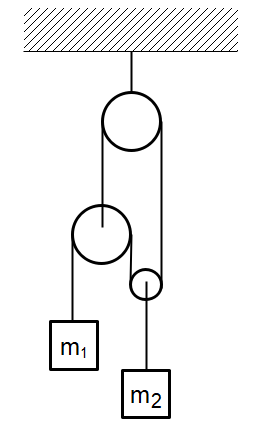
Pulley mass system is shown in figure string and pulleys and strings are ideal. Acceleration of \[{m_2}\] and ${m_1}$ will be:

A) ${a_1} = 2{a_2}$
B) ${a_1} = 2{a_1}$
C) ${a_1} = {a_2} = g$
D) ${a_1} = 3{a_2}$
Answer
180k+ views
Hint: In this solution, we will draw the free body diagram of the string pulley system. Then we will calculate the tension in the strings to calculate the acceleration in the two blocks.
Complete step by step answer:
Let us start by drawing a free body diagram of the tension in the different strings.

AS we can see, for the mass ${m_1}$ the mass it experiences is associated with only the bottom left pulley. Hence, we can write the equation of motion for the first mass as:
$T = m{a_1}$
Now the string connecting the lower two pulleys is the same so the net displacement will be zero. Also, we can see that for the pulley in the bottom right, the tension in the two strings will be $2T$ as can be seen from the diagram. Also, the tension in the string can be represented as the acceleration of the object which will be
$T = 2m{a_2}$
Since the tension will be the same in the string for both the bottom pulleys, we have
$m{a_1} = 2m{a_2}$
So, the relation of the acceleration of the two blocks will be
${a_1} = 2{a_2}$
Hence the correct choice will be choice (A).
Note: We can intuitively expect the first mass to have higher acceleration since it will have to compensate for the tension exerted by the other mass as it is connected by two pulleys. As a result, the displacement of the first block will always be higher than the displacement of the second block. We shouldn’t worry about the movement of individual pulleys but only the tension in the strings as it simplifies our calculations.
Complete step by step answer:
Let us start by drawing a free body diagram of the tension in the different strings.

AS we can see, for the mass ${m_1}$ the mass it experiences is associated with only the bottom left pulley. Hence, we can write the equation of motion for the first mass as:
$T = m{a_1}$
Now the string connecting the lower two pulleys is the same so the net displacement will be zero. Also, we can see that for the pulley in the bottom right, the tension in the two strings will be $2T$ as can be seen from the diagram. Also, the tension in the string can be represented as the acceleration of the object which will be
$T = 2m{a_2}$
Since the tension will be the same in the string for both the bottom pulleys, we have
$m{a_1} = 2m{a_2}$
So, the relation of the acceleration of the two blocks will be
${a_1} = 2{a_2}$
Hence the correct choice will be choice (A).
Note: We can intuitively expect the first mass to have higher acceleration since it will have to compensate for the tension exerted by the other mass as it is connected by two pulleys. As a result, the displacement of the first block will always be higher than the displacement of the second block. We shouldn’t worry about the movement of individual pulleys but only the tension in the strings as it simplifies our calculations.
Recently Updated Pages
Uniform Acceleration - Definition, Equation, Examples, and FAQs

JEE Atomic Structure and Chemical Bonding important Concepts and Tips

JEE Amino Acids and Peptides Important Concepts and Tips for Exam Preparation

JEE Electricity and Magnetism Important Concepts and Tips for Exam Preparation

Chemical Properties of Hydrogen - Important Concepts for JEE Exam Preparation

JEE Energetics Important Concepts and Tips for Exam Preparation

Trending doubts
JEE Main 2025 Session 2: Application Form (Out), Exam Dates (Released), Eligibility, & More

JEE Main 2025: Derivation of Equation of Trajectory in Physics

Displacement-Time Graph and Velocity-Time Graph for JEE

Atomic Structure - Electrons, Protons, Neutrons and Atomic Models

Learn About Angle Of Deviation In Prism: JEE Main Physics 2025

What is Hybridisation in Chemistry?

Other Pages
NCERT Solutions For Class 11 Physics Chapter 2 Motion In A Straight Line - 2025-26

NCERT Solutions For Class 11 Physics Chapter 1 Units and Measurements - 2025-26

NCERT Solutions For Class 11 Physics Chapter 3 Motion In A Plane - 2025-26

JEE Advanced Marks vs Ranks 2025: Understanding Category-wise Qualifying Marks and Previous Year Cut-offs

Units And Measurements Class 11 Physics Chapter 1 CBSE Notes - 2025-26

Motion in a Straight Line Class 11 Physics Chapter 2 CBSE Notes - 2025-26




